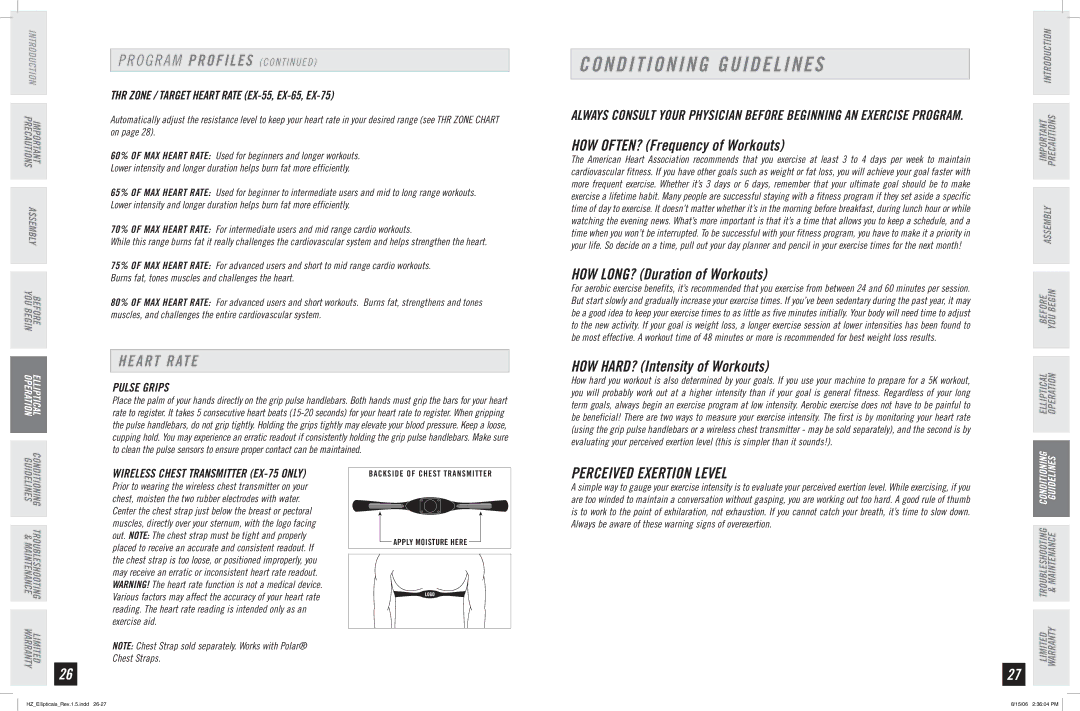
INTRODUCTION IMPORTANT PRECAUTIONS
ASSEMBLY
BEFORE YOU BEGIN
ELLIPTICAL OPERATION
Pr o g r a m Profiles (continued)
THR ZONE / Target Heart Rate (ex-55, EX-65, EX-75)
Automatically adjust the resistance level to keep your heart rate in your desired range (see THR ZONE CHART on page 28).
60% of Max Heart Rate: Used for beginners and longer workouts. Lower intensity and longer duration helps burn fat more efficiently.
65% of Max Heart Rate: Used for beginner to intermediate users and mid to long range workouts. Lower intensity and longer duration helps burn fat more efficiently.
70% of Max Heart Rate: For intermediate users and mid range cardio workouts.
While this range burns fat it really challenges the cardiovascular system and helps strengthen the heart.
75% of Max Heart Rate: For advanced users and short to mid range cardio workouts. Burns fat, tones muscles and challenges the heart.
80% of Max Heart Rate: For advanced users and short workouts. Burns fat, strengthens and tones muscles, and challenges the entire cardiovascular system.
HEART RATE
Pulse grips
Place the palm of your hands directly on the grip pulse handlebars. Both hands must grip the bars for your heart rate to register. It takes 5 consecutive heart beats
CONDITIONING GUIDELINES
Always consult your physician before beginning an exercise program.
HOW OFTEN? (Frequency of Workouts)
The American Heart Association recommends that you exercise at least 3 to 4 days per week to maintain cardiovascular fitness. If you have other goals such as weight or fat loss, you will achieve your goal faster with more frequent exercise. Whether it’s 3 days or 6 days, remember that your ultimate goal should be to make exercise a lifetime habit. Many people are successful staying with a fitness program if they set aside a specific time of day to exercise. It doesn’t matter whether it’s in the morning before breakfast, during lunch hour or while watching the evening news. What’s more important is that it’s a time that allows you to keep a schedule, and a time when you won’t be interrupted. To be successful with your fitness program, you have to make it a priority in your life. So decide on a time, pull out your day planner and pencil in your exercise times for the next month!
HOW LONG? (Duration of Workouts)
For aerobic exercise benefits, it’s recommended that you exercise from between 24 and 60 minutes per session. But start slowly and gradually increase your exercise times. If you’ve been sedentary during the past year, it may be a good idea to keep your exercise times to as little as five minutes initially. Your body will need time to adjust to the new activity. If your goal is weight loss, a longer exercise session at lower intensities has been found to be most effective. A workout time of 48 minutes or more is recommended for best weight loss results.
HOW HARD? (Intensity of Workouts)
How hard you workout is also determined by your goals. If you use your machine to prepare for a 5K workout, you will probably work out at a higher intensity than if your goal is general fitness. Regardless of your long term goals, always begin an exercise program at low intensity. Aerobic exercise does not have to be painful to be beneficial! There are two ways to measure your exercise intensity. The first is by monitoring your heart rate (using the grip pulse handlebars or a wireless chest transmitter - may be sold separately), and the second is by evaluating your perceived exertion level (this is simpler than it sounds!).
IMPORTANT PRECAUTIONS INTRODUCTION
ASSEMBLY
BEFORE YOU BEGIN
ELLIPTICAL OPERATION
CONDITIONING TROUBLESHOOTING LIMITED
GUIDELINES & MAINTENANCE WARRANTY
26
WIRELESS CHEST TRANSMITTER (EX-75 ONLY)
Prior to wearing the wireless chest transmitter on your chest, moisten the two rubber electrodes with water. Center the chest strap just below the breast or pectoral muscles, directly over your sternum, with the logo facing out. NOTE: The chest strap must be tight and properly placed to receive an accurate and consistent readout. If the chest strap is too loose, or positioned improperly, you may receive an erratic or inconsistent heart rate readout. WARNING! The heart rate function is not a medical device. Various factors may affect the accuracy of your heart rate reading. The heart rate reading is intended only as an exercise aid.
NOTE: Chest Strap sold separately. Works with Polar® Chest Straps.
BACKSIDE OF CHEST TRANSMITTER
APPLY MOISTURE HERE
PERCEIVED EXERTION LEVEL
A simple way to gauge your exercise intensity is to evaluate your perceived exertion level. While exercising, if you are too winded to maintain a conversation without gasping, you are working out too hard. A good rule of thumb is to work to the point of exhilaration, not exhaustion. If you cannot catch your breath, it’s time to slow down. Always be aware of these warning signs of overexertion.
27
LIMITED TROUBLESHOOTING CONDITIONING WARRANTY & MAINTENANCE GUIDELINES
HZ_Ellipticals_Rev.1.5.indd | 8/15/06 2:36:04 PM |
